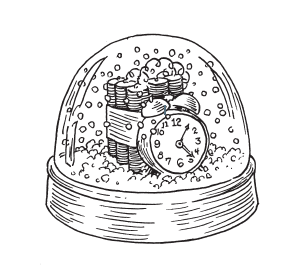The other day I went into the Logan Airport Hudson News to buy a Boston snow globe. At first, I couldn’t find one. Then I spotted a few huddled on the top shelf behind the baked bean T-shirts. I brought down a skyline model with confetti stars and brought it to the register.
“You can’t take this through,” the clerk said.
He tilted his head over to the woman sitting at a desk at security writing down the list of liquids passengers wanted to take on the plane.
“Well, you can ask her, but there’s too much water in this.” Too much water. The liquid ban.
Snow globes—literal globalizations—have become the latest victims of terrorism. I fear for the future of my collection.
I started collecting snow domes in grad school. I was studying English in the mid-’90s, gleefully analyzing popular cultural artifacts, both paying homage (because we were flattening the hierarchy of art) and poking fun. Snow globes fit perfectly into the zeitgeist and I started buying the oddest ones I could find. One of my greatest finds I picked up at Gettysburg. Titled “The War Between the States,” it depicts two soldiers in the foreground: the blue one holds a rifle on his shoulder and stands next to a cannon; the green one grips a rifle pointed down. In the background, crossed over each other, are the Union Jack and Confederate flags. A war encased in plastic.
Snow globes are quintessential Americana: plastic, bright, devoid of grit or history. They promise permanence but are ultimately ephemeral: the snow stops falling as soon as your wrist tires, and the water will evaporate over the years. The ur-American movie Citizen Kane famously opens with the illusion of a perfect wintry scene, only to pull back and reveal the snow globe. In Home Town, Tracy Kidder characterizes the treacherous allure of small town America as a snow dome:
From the summit, the cornfields are a dream of perfect order, and the town seems entirely coherent, self-contained, a place where a person might live a whole life and consider it complete, a tiny civilization all its own. Forget the messiness of years and days—every work of human artifice has a proper viewing distance. The town below fits in the palm of your hand. Shake it and it snows.
Snow globes are French in origin. The first boule de neige was an Eiffel Tower scene, for sale all over the International Exposition in Paris in 1889, which commemorated the centenary of the French Revolution. By 1920 this now popular European souvenir came to America. In the ’50s, plastics took over the formerly glass dome production. They have been steady sellers ever since; in the past decade or so they have become more popular, taking on higher-priced real estate in airports and gift shops. They busted out of their domes, too: there is a San Francisco star, a Manhattan triangle, and a Boston octagon.
When my son was a preschooler,...
You have reached your article limit
Sign up for a digital subscription and continue reading all new issues, plus our entire archives, for just $1.50/month.
Already a subscriber? Sign in





